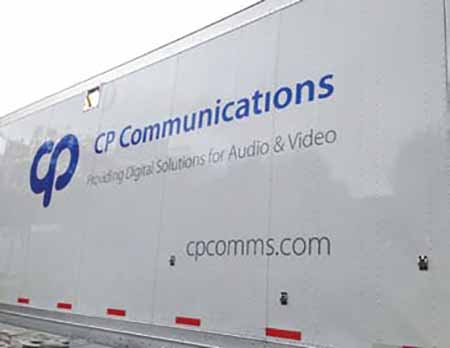Future-Proofing for 4K
ELMSFORD, N.Y.—CP Communications is building 4K signal carriage capability into HD21, a new 53-foot transmission and master control truck being built for Fox Sports’ golf coverage. Specifically, the Elmsford, N.Y.-based production services company is incorporating Calient Technologies’ S320 Optical Circuit Switches into this mobile trailer.

CP Communications’ HD21 production truck
“The S320s will optically switch audio/ video signals carried on optical fiber cables from golf course camera positions to Fox Sports’ mobile production facilities,” said Chris Schwartzer, CP Communications’ golf project manager. “They will also feed the produced video feeds from the mobile production facilities to Fox Sports for distribution via cable and satellite TV.” HD21’s first scheduled shoot was the Franklin Templeton Shootout in Naples, Fla., Dec. 8-13.
BANDWIDTH HEADROOM
CP Communications’ decision to employ fiber-optic signal carriage within HD21 breaks the bandwidth constraints of metal-based signal carriage; be it twisted pair, coax, or CAT5. This is because each of HD21’s single-mode fiber-optic cables can carry more than 100 Gbps’ worth of data, far more than the 12 Gbps needed to move 4K video. Add the fact that S320 can switch between 320 single-mode fiber inputs and outputs, and HD21 actually has enough bandwidth to support 8K video; even 16K!
That said, CP Communications didn’t choose fiber-optic cables to carry higher than 1080p signals per se, but rather because fiber-optic signal carriage doesn’t have the same restrictions as metal-based carriage when it comes to signal loss and distance limitations.
“We have a lot of ground to cover when we’re producing golf,” Schwartzer said. “Using fiber-optic cables to link our field cameras back to the production trailers is the most effective way to do it.”

CP Communications is incorporating Calient Technologies’ S320 Optical
Circuit Switches into its new HD21 mobile production truck.
The professional video industry's #1 source for news, trends and product and tech information. Sign up below.
COOL ROUTING TECHNOLOGY
Because it is routing optical light sources rather than electrical signals, the S320 optical circuit switches from Calient Technologies, a Santa Barbara, Calif.-based developer of photonic optical circuit switching technology, do not use any direct physical connections between incoming and outgoing sources. Instead, all signal switching is done using mirrors; specifically tiny 3D optical MEMs mirrors. Short for “Microelectromechanical systems,” MEMS mirrors are micro-machined from silicon and can rotate vertically and horizontally, with their motions being triggered electrically by the switching router.
Since the S320 switches between 320 incoming and outgoing fiber-optic sources, the S320 has two banks of 320 MEMS mirrors aligned between them. The incoming and outgoing fiber connections are each combined into separate 320 fiber blocks, with their open termination ends exposed. Each block has a bank of 320 MEMS mirrors nearby set at a 45 degree angle, with the ability for one bank of MEMs mirror to reflect light onto the other bank’s mirrors.
When an optical light source needs to be routed—for example, from a camera on the 18th green to the master control switcher—the light exits the incoming fiber and hits a MEMS mirror. This mirror rotates to reflect the laser light onto a MEMS mirror on the second MEMS mirror bank. It has already been rotated to reflect the light into the outgoing fiber that is connected to the master control switcher.
“There is a tiny bit of light loss due to the air space between the incoming/outgoing fiber-optic ends and the MEMs mirrors,” said Daniel Tangent, Calient Technologies’s vice president of marketing. “But the loss is so small that it has no real effect on the system’s ability to carry optical signals over long distances. Besides, the incoming light source can always be amplified, if need be, and you are not going to see distances that large when covering golf on site.”
4K YET TO COME
CP Communications’ use of fiber-optic switching in HD21 does not mean that this company is embracing 4K production; at least not at this time.
“There really isn’t any demand for 4K production capabilities from Fox Sports, or any other of our broadcast clients,” said Schwartzer. “This is why HD21 has been built as an HD-level production facility. It doesn’t make sense to spend extra money for 4K capacity when it is still at the bleeding edge, and not being requested by broadcasters.”
Nevertheless, the fact that fiber-optic signal transmission provides more than enough bandwidth to transport for 4K and higher resolution signals may indicate a scalable pathway to supporting these technologies over time.
Put plainly, the use of signal switching and transportation technologies that are independent of specific video resolutions— be they 1080p, 4K, or 8K—may allow mobile production and broadcast facility integrators to build infrastructures that can be re-used rather than replaced whenever the Next Big Resolution standard catches on. Certainly this is the very flexibility that CP Communications has built into HD21, by adopting optical signal switching and transportation. As a result, HD21 has a degree of “future-proofing” that will allow it to move up to 4K without being gutted and entirely rebuilt, should that need ever arise.
James Careless is an award-winning journalist who has written for TV Technology since the 1990s. He has covered HDTV from the days of the six competing HDTV formats that led to the 1993 Grand Alliance, and onwards through ATSC 3.0 and OTT. He also writes for Radio World, along with other publications in aerospace, defense, public safety, streaming media, plus the amusement park industry for something different.

